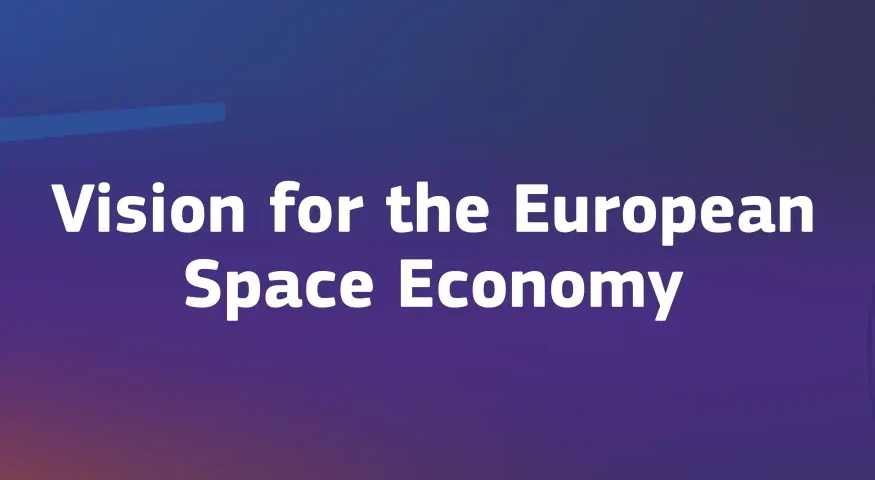
The space economy encompasses all economic activities, both on Earth and in space, enabled by space technologies, services, and infrastructure. Below is our brief summary, including key points from the Vision for the European Space Economy relevant to research, which we have highlighted for quick reference. The strategy is particularly interesting as it indicates the themes European funding will focus on in the future.
Why is a unified EU strategy for the space economy needed?
- The economic value of this sector is expected to reach 1.8 trillion USD by 2035.
- The United States and China leverage space to achieve strategic objectives (military, economic, scientific, and political) through ambitious space programs focused on the Moon and Mars. These drive a wave of investments and stimulate innovation in space across various fields.
- Increasing competition is also evident in Earth’s orbit, where a growing number of established and emerging space powers introduce innovative technologies.
- The development of reusable heavy-lift rockets combined with the mass production of thousands of satellites grouped into mega-constellations is revolutionizing access to space. These needs underscore the importance of introducing sustainable technologies and services in space to ensure the long-term viability of space operations.
- Europe has lost its leading position in the commercial rocket and satellite communication markets. Additionally, the European space sector could benefit from updated governance rules, investment strategies, and greater coordination of public spending within a true single market for space.
- Foreign government spending exceeds EU spending, which is between 15% and 20% of the U.S. level, and private investments in the EU account for only 15% of total expenditure.

How to achieve this?
Space as a market sector enabling European competitiveness
The EU must make faster progress in strategic areas such as access to space, satellite communication, Earth observation, positioning, navigation and timing, space safety, artificial intelligence, quantum technologies, defense synergies, and space operations and services. EU support will therefore be built on six pillars:
- Creating a single EU space market to complement the EU Space Law as an overarching framework, enabling businesses to operate more seamlessly and efficiently across borders;
- Accelerating space research and innovation by developing innovative technologies and strengthening global competitiveness through increased funding under FP10, defense synergies, and strengthening dedicated partnerships;
- Enhancing industrial readiness and technological independence by strengthening the EU’s industrial base, ensuring technological sovereignty, and reducing reliance on external supply chains;
- Promoting space commercialization within the EU and providing support through flexible procurement, customer contracts, and increased investments to foster a more dynamic EU space economy;
- Maintaining strong international cooperation as a priority to ensure a connected and future-ready space ecosystem, including through sharing information on procurement processes outside the EU;
- Strengthening a highly skilled workforce in line with the Union of Skills while leveraging digitalization and automation to enhance productivity and efficiency.
Supporting space solutions to bolster the European economy through:
- Infrastructure and manufacturing:
- Facilitating the expansion and modernization of manufacturing and testing facilities across the EU;
- Increasing investments in next-generation satellite technology (including, but not limited to, software-defined satellites, quantum satellites, commercial navigation satellites, and satellite cybersecurity);
- Establishing manufacturing accelerators under CASSINI to provide advisory services for the space industry to optimize manufacturing processes, logistics, and supply strategies;
- Access to space:
- Promoting EU preference in access to space while ensuring a competitive procurement process for EU institutional launch services, including through aggregation and joint procurement;
- Contributing to the maintenance, security, and expansion of ground infrastructure capacities;
- Contributing to accelerating future access-to-space solutions, such as through reusability;
- Digital infrastructure for space:
- Supporting sovereign EU cloud solutions for space data to reduce reliance on non-EU platforms for storing, processing, and distributing satellite data and enhance the competitiveness of EU solutions;
- Supporting the modernization of ground segments by continuing the transition to digital, cloud-based, and virtualized infrastructures;
- Supporting the creation of space data labs to provide researchers, developers, and businesses with a collaborative environment for experimenting with data, training AI models, and developing new applications;
- Space for security and defense:
- Supporting public demand for dual-use services and related technologies through aggregation, joint procurement, and anchoring agreements;
- Continuing and strengthening its security-by-design policy in the development of its space systems and subsequent service provision, taking into account dual-use principles;
- Exploring the potential for expanded dual-use space systems, i.e., government Earth observation, positioning, navigation, and timing services on low Earth orbit, IRIS², radio interference monitoring, and space situational awareness;
- Supporting space services and simplification:
- Implementing innovative procurement in the space sector, particularly for public authorities purchasing space services and data, using a dynamic procurement system that aggregates public authority requirements and alleviates local and regional levels from complex procurement processes through a single, simplified centralized approach;
- Launching the “Make it with Space” program, a dedicated EU funding program to enable new users to test, evaluate, and implement space solutions into their business processes, making them more efficient, sustainable, and resilient while avoiding disruption to competition;
Leveraging the space economy through:
- Exploring the possibility of a pilot ISOS mission (In Space Operations and Services) by 2030 (and next-generation space infrastructure) and laying the groundwork for a new strategic flagship project by 2035, providing on-demand services in space for maintenance, upgrades, assembly, manufacturing, repairs, debris removal, recycling, and logistics for satellites and other space objects;
- Preparing conditions and supporting the development of enabling technologies for demonstration projects of space data centers and distributed computing power in space;
- Coordinating research activities in resource extraction and utilization, development of scientific instruments, and cooperative and interoperable robotics.
To implement this ambitious vision, the Commission will establish “Space Team Europe,” an advisory body to assist in preparing the Action Plan for this strategy, titled the “EU Space Master Plan.”
Published on 10.7.2025, slord
